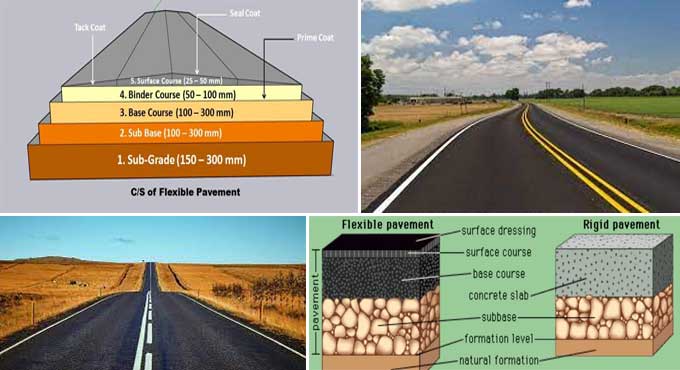
A Guide to the Types & Components of Road Pavement

As the road carriageway, the road pavement is supported by layers of subgrade soil. The main purpose is to distribute vehicle loads evenly over the subgrade through the layers. Pavements should have sufficient skid resistance, good ride quality, good light reflection properties, and low noise emissions.
This is done so that the vehicles won't exceed the sub-grade's bearing capacity. In any construction project, road paving plays a pivotal role. Pavements for roads are generally either flexible or rigid. Wheel loads of heavy vehicular traffic carry in it. Vehicle loads should distribute over a large subgrade area.
The purpose of a smooth surface is to provide a safe driving surface for vehicles. You can prevent subgrade soil from being affected by weathering agents.
Requirements of Road Pavement
1. A sufficient layer of soil thickness is necessary on the sub-grade to take the stresses from wheel loads into account.
2. All types of stresses imposed on it must be able to withstand its strong structural integrity.
3. Having enough friction will prevent vehicles from skidding.
4. The surface should offer road users comfort even at high speeds.
5. When a vehicle travels over it, reduce the noise.
6. Dust may pose a threat to traffic safety if the road is not dust-proof.
7. In order to effectively protect sub-grade soil, an impervious surface is needed.
8. A low-maintenance product should have a long lifespan.<
Components Parts of Road Pavement Structure
1. Base Course or Foundation Course.
2. Base Coat or Intermediate Course.
3. Sub-grade or Formation.
4. Sub-base.
5. Wearing Course.
Base Course or Foundation Course
Base course in pavements is a layer of boulders or bricks laid in a double layer over the sub-base or directly over the sub-grade if there is no sub-base.
Despite high shearing stresses, it can withstand traffic impacts to the wearing course. This subgrade and sub-base serve as a foundation for the pavement and transfer load to the pavement above it.
Base Coat or Intermediate Course
Base coating refers to the layer of stones that lies between the base and wear course of a road pavement. This layer is sometimes called a bearing course or intermediate coat. The main function of the base course is to transmit load over a large area. It acts as a layer of transmission material.
Sub-grade or Formation
Road pavements rest on a subgrade or formation, which is a finished earthwork that has compacted. It provides support for the pavement. All pavement loads, including traffic, are carried by the subgrade.
Sub-base
A sub-base is the layer of granular material between the subgrade and the base course of a road pavement. Subgrades strengthen by strengthening sub-base. Drainage is improved, and water capillary rise in the soil keeps under control.
The sub-base serves as structural support, provides drainage, and reduces the intrusion of fines into the pavement structure. In the case of a base, this is an open-graded course, and then subgrade material with more fine material can be used as filler between subgrade and base.
It is not strictly necessary to use a sub-base. A sub-base course may not need pavement made over a hard subgrade with good quality. When this is the case, avoiding the sub-base course is possible.
Wearing Course
Wearing course refers to the topmost layer of pavement that is directly exposed to traffic. A principal purpose of the wearing course is to prevent water from entering the base course by providing impervious layers. In addition, the entire traffic load is evenly distributed across the base course, which is impervious, so that water cannot enter the base course.
Often referred to as pile caps or caissons, grade beams are a component of a building's foundation that transmits the load from bearing walls to a spaced foundation. Each grade beam provides support to the structure.
Types of Road Pavement
Rigid Pavement: Rigid pavements cannot change their shape without rupturing. Pavements made of cement concrete are examples of rigid pavement.
Flexible Pavement: It is known as flexible pavement when it can change its shape without rupturing. Pavements made from bituminous material, gravel pavements, and hardened macadam pavements are examples of flexible pavements.
The flexible pavements are popular in India because of the following reasons:
1. Construction is easy and cheap.
2. The construction of a road pavement can be easily done with locally available materials.
3. Less supervision is required.
Conclusion
Every type of traffic should accommodate by road pavement. Construction should be less expensive, durable, and strong. Nighttime visibility should be excellent. Driving a bike or riding a car should be safe and comfortable on pavements. The cost of its maintenance should be low.


